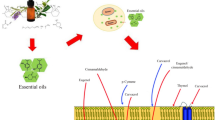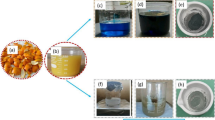Abstract
The purpose of this study was to develop and assess the antimicrobial properties of silver nanoparticles (AgNPs)-based whey emulsions and edible films for extending the shelf life of fruits and vegetables. The AgNPs were synthesized using a biological method, and their morphological and topographical characteristics were evaluated using scanning electron microscopy (SEM). The AgNPs were incorporated into the emulsions and films to increase their antimicrobial efficacy. Bacterial and fungal strains were identified by DNA regions, including 16S and 18S rRNA, TEF-1α, and RPB2 to evaluate antimicrobial activity. AgNPs-based emulsions and films were used to extend the shelf life of fruits and vegetables for up to 15 days. The results showed that the use of AgNPs in the coated samples significantly increased their effectiveness against bacterial and fungal strains. SEM analysis revealed the presence of AgNPs of varying sizes, ranging from 21 to 62 nm. The zones of inhibition were measured against Staphylococcus aureus, Escherichia coli, Salmonella enterica, Aspergillus flavus, Aspergillus tamari, and Aspergillus niger. The total viable count (log cfu/ml) decreased from 6.423 in the control group to 3.301 in the treated samples. The antioxidant activity of the treated fruits and vegetables was also significantly improved, with values of 56.12, 23.36, 26.10, 7.6, 36.04, and 33.81% for strawberry, taro root, guava, peas, green chili, and carrot, respectively (p < 0.05). The AgNPs-based whey protein emulsions were found to exhibit the highest antimicrobial activity and are therefore a promising approach to extend the shelf life of fruits and vegetables.





Similar content being viewed by others
Data Availability
All phylogeny data files are based on accession numbers which are available in the Genbank of NCBI database.
References
Newell DG et al (2010) Food-borne diseases—the challenges of 20 years ago persist while new ones continue to emerge. Int J Food Microbiol 139(12):S3–S15
Pasquaretta C et al (2018) Exploring interactions between the gut microbiota and social behavior through nutrition. Genes 9(6):534–540
Borchers A et al (2010) Food safety. Clin Rev Allergy Immunol 39(5):95–141. https://doi.org/10.1007/s12016-009-8176-4
Laranjo M et al (2019) Shelf-life extension and quality improvement of a Portuguese traditional ready-to-eat meat product with vinegar. Int J Food Sci Technol 54(6):132–140. https://doi.org/10.1111/ijfs.13913
Kanter R et al (2015) A conceptual framework for understanding the impacts of agriculture and food system policies on nutrition and health. Food Secur 7(4):767–777
Pinu FR (2016) Early detection of food pathogens and food spoilage microorganisms: application of metabolomics. Trends Food Sci Technol 54(12):213–215
Ashaolu TJ, Ashaolu JO (2020) Perspectives on the trends, challenges and benefits of green, smart and organic (GSO) foods. Int J Gastron Food Sci 22(12):100273–100279
Anderson JG et al (2000) Inactivation of food-borne enteropathogenic bacteria and spoilage fungi using pulsed-light. IEEE Trans Plasma Sci 28(5):2883–2892
Malhotra B, Keshwani A, Kharkwal H (2015) Antimicrobial food packaging: potential and pitfalls. Front Microbiol 6(4):611–617. https://doi.org/10.3389/fmicb.2015.00611/full
Zhang H et al (2020) Microbiological safety of ready-to-eat fresh-cut fruits and vegetables sold on the Canadian retail market. Int J Food Microbiol 335(11):108–855
Maes S et al (2019) Identification and spoilage potential of the remaining dominant microbiota on food contact surfaces after cleaning and disinfection in different food industries. J food prot 82(6):262–275
Arabpoor B et al (2021) Multifunctional coating composed of Eryngium campestre L. essential oil encapsulated in nano-chitosan to prolong the shelf-life of fresh cherry fruits. Food Hydrocoll 111(4):106394–106399
Gautam RB, Kumar S (2017) Development of protein based films with nanoparticle as strengthening material for biodegradable packaging—A review. Int J Agric Innov Res 5(2):790–805
Mikš-Krajnik M et al (2015) Ensuring food security through enhancing microbiological food safety. Cosmos 11(8):69–97
Garba U, Kaur S (2014) Protein isolate production, functional properties and applications. Int Res J Chem 4(2):22–36
Doultani S, Turhan KN, Etzel MR (2004) Fractionation of proteins from whey using cation exchange chromatography. Process Biochem 39(6):1737–1743
Dakal TC et al (2016) Mechanistic basis of antimicrobial actions of silver nanoparticles. Front Microbiol 7(4):18–31
Yue T, Zhang X (2011) Molecular understanding of receptor-mediated membrane responses to ligand-coated nanoparticles. Soft Matter 7(9):9104–9112
Gugala N et al (2019) Specificity in the susceptibilities of Escherichia coli, Pseudomonas aeruginosa and Staphylococcus aureus clinical isolates to six metal antimicrobials. Antibiotics 8(2):51–58
Ghosh S et al (2012) Synthesis of silver nanoparticles using Dioscorea bulbifera tuber extract and evaluation of its synergistic potential in combination with antimicrobial agents. Int J Nanomed 7(2):483
Pal S, Tak YK, Song JM (2007) Does the antibacterial activity of silver nanoparticles depend on the shape of the nanoparticle? A study of the gram-negative bacterium Escherichia coli. Appl Environ Microbiol 73(4):1712–1720. https://doi.org/10.1128/AEM.02218-06
Priyadarshi R, Rhim JW (2020) Chitosan-based biodegradable functional films for food packaging applications. Innov Food Sci Emerg Technol 62(10):102–346
Pereda M, Amica G, Marcovich NE (2012) Development and characterization of edible chitosan/olive oil emulsion films. Carbohydr Polym 87(12):1318–1325
Istiqola A, Syafiuddin A (2020) A review of silver nanoparticles in food packaging technologies: regulation, methods, properties, migration, and future challenges. J Chin Chem Soc 67(8):1942–1956
Kalaiselvan V, Rajasekaran A (2009) Biosynthesis of silver nanoparticles from Aspergillus niger and evaluation of its wound healing activity in experimental rat model. Int J Pharm Tech Res 4(2):1523–1529
Mohanta YK, Behera SK (2014) Biosynthesis, characterization and antimicrobial activity of silver nanoparticles by Streptomyces sp SS2. Bioprocess Biosyst Eng 37(9):2263–2269. https://doi.org/10.1007/s13204-013-0233-x
Kjeldahl C (1883) A new method for the determination of nitrogen in organic matter. Z Anal Chem 22(3):366–372
Kleyn DH et al (2001) Determination of fat in raw and processed milks by the Gerber method: collaborative study. J AOAC Int 84(7):1499–1508
Al-Nabulsi AA et al (2015) Occurrence and antibiotic susceptibility of Listeria monocytogenes isolated from raw and processed meat products in Amman. Jordan. CYTA J Food 13(5):346–352
Diez B et al (2001) Application of denaturing gradient gel electrophoresis (DGGE) to study the diversity of marine picoeukaryotic assemblages and comparison of DGGE with other molecular techniques. Appl Environ Microbiol 67(7):2942–2951. https://doi.org/10.1128/aem.67.7.2942-2951.2001
Singh JP et al (2016) Composition, bioactive compounds and antioxidant activity of common Indian fruits and vegetables. J Food Sci Technol 53(11):4056–4066. https://doi.org/10.1007/s13197-016-2412-8
Marambio-Jones C, Hoek EM (2010) A review of the antibacterial effects of silver nanomaterials and potential implications for human health and the environment. J Nanopart Res 12(9):1531–1551. https://doi.org/10.1007/s11051-010-9900-y
Lefèvre T, Subirade M, Pézolet M (2005) Molecular description of the formation and structure of plasticized globular protein films. Biomacromol 6(2):3209–3219. https://doi.org/10.1021/bm050540u
Banerjee R, Chen H (1995) Functional properties of edible films using whey protein concentrate. J Dairy Sci 78(8):1673–1683
Jiang Y et al (2010) Study of the physical properties of whey protein isolate and gelatin composite films. JAgri Food Chem 58(8):5100–5108
Abdalrazeq M et al (2021) Physicochemical and antimicrobial properties of whey protein-based films functionalized with Palestinian Satureja capitata essential oil. Coatings 11(11):1364–1370
Wing-ShanáLin I (2014) Biosynthesis of silver nanoparticles from silver (I) reduction by the periplasmic nitrate reductase c-type cytochrome subunit NapC in a silver-resistant E. coli. Chem Sci J 5(9):3144–3150
Singh T et al (2017) Biosynthesis, characterization and antibacterial activity of silver nanoparticles using an endophytic fungal supernatant of Raphanus sativus. J Genet Eng Biotechnol 15(4):31–39
Balakrishnan S et al (2017) Biosynthesis of silver nanoparticles using Myristica fragrans seed (nutmeg) extract and its antibacterial activity against multidrug-resistant (MDR) Salmonella enterica serovar Typhi isolates. Environ Sci Pollut Res 24(5):14758–14769. https://doi.org/10.1007/s11356-017-9065-7
Carbone M et al (2016) Silver nanoparticles in polymeric matrices for fresh food packaging. J King Saud Univ Sci 28(4):273–279
Vignesh R, Nair BR (2019) Improvement of shelf life quality of tomatoes using a novel edible coating formulation. Plant Sci Today 6(8):84–90
Das R, Medhi G (1996) Physio-chemical changes of pineapple fruits under certain postharvest treatments. Indian J Hortic. 44(2):5–7
Shanky B (2013) Minimal processing and preservation of fruits and vegetables by active packaging. Int J Herb Med 1(11):131–138
Del-Valle V et al (2005) Development of a cactus-mucilage edible coating (Opuntia ficus indica) and its application to extend strawberry (Fragaria ananassa) shelf-life. Food chem 91(2):751–756
Song NB et al (2014) Development of a chicken feather protein film containing clove oil and its application in smoked salmon packaging. Food Sci Technol 57(12):453–460
Acknowledgements
The authors would like to thank the University of Central Punjab for providing experimental facilities and Dr. Abdul Ahad Rasheed for helping in conducting the quality tests for whey protein isolates.
Funding
This study was financially supported by the University of Central Punjab.
Author information
Authors and Affiliations
Contributions
SA executed the experimental work and wrote the draft. AA designed this study, analyzed data, and revised the draft. AS helped in reviewing the draft. HGMS proofread the revisions. AH supported in conducting some experiments.
Corresponding author
Ethics declarations
Conflict of interest
The authors have declared no conflict of interest in this study.
Informed Consent
Not applicable.
Consent for Publications
Not applicable.
Research Involving Human Participants and/or Animals
This article does not contain any studies with human participants or animals performed by any of the authors.
Additional information
Publisher's Note
Springer Nature remains neutral with regard to jurisdictional claims in published maps and institutional affiliations.
Supplementary Information
Below is the link to the electronic supplementary material.
Rights and permissions
Springer Nature or its licensor (e.g. a society or other partner) holds exclusive rights to this article under a publishing agreement with the author(s) or other rightsholder(s); author self-archiving of the accepted manuscript version of this article is solely governed by the terms of such publishing agreement and applicable law.
About this article
Cite this article
Rasheed, S., Amin, A., Sarwar, A. et al. Evaluation of Antimicrobial Effect of Silver Nanoparticle Based Whey Emulsions and Edible Films for the Extension of Shelf Life of Fruits and Vegetables. Curr Microbiol 80, 158 (2023). https://doi.org/10.1007/s00284-023-03275-3
Received:
Accepted:
Published:
DOI: https://doi.org/10.1007/s00284-023-03275-3




